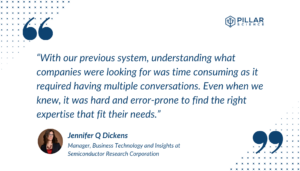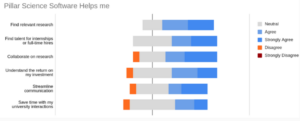Once a simple business transaction of currency for information, the industry and academia collaboration has transformed its relationship from donors to investors. Research universities have always been at the mercy of the federal government when it came to funding and corporations were constantly looking to innovate. These intersecting needs created a road for corporations to become directly involved with research universities, increasing academic industry collaborations.
This hands-on approach by corporations led to industry research being outsourced to many universities – 20% of all R&D are done by a university –, which permitted corporations to accelerate their product development and gain early access to qualified talents. For universities, industry and academia collaborations allow their teams to leverage their expertise to have a greater impact. However, while universities have the potential to offer transformational partnerships, including research, talents and philanthropy, relationships oftentimes remain strictly transactional.
According to the Network of Academic Corporate Relations Officers (NACRO), the level of satisfaction of companies with universities is not great (63/100), among other things because communication is considered unsatisfactory. More and more companies want to be able to measure their ROI to gauge the success of their partnership with universities. In other words, they want not only their money, but their time to be well spent—a plight once faced by The Semiconductor Research Corporation.
SRC’s Challenge: Aligning Academic Expertise with the Right Corporate Partner
The Semiconductor Research Corporation (SRC) is a world-renowned, high technology-focused research consortium that serves as a crossroads for technology industry and academia collaborations. SRC works with a substantial number of industry members that have a variety of research interests, which made it difficult to know exactly what companies were looking for. As an organization working with hundreds of universities across the US, SRC found it challenging to effectively align academic expertise with what companies were looking for.
Their existing matching process was outdated and overly cumbersome — feeling something like those vexing hours spent wandering the aisles of a Blockbuster searching for the perfect movie.

It was important for SRC to improve this matchmaking process so that it could better support its industry members in starting work on projects with specific professors, discovering qualified talents and increasing the scale of those partnerships. Limited resources, however, meant that any solution SRC selected would have to bring efficient gains.
At the time, SRC was relying on a CRM and custom aging technology platforms. These systems contained a lot of partial, stale data and were heavily reliant on manual data entry from a select number of employees. SRC initially tried customizing market-leading software solutions to fit its university-industry partnership needs. However, despite all the financial, time, and staffing-related commitments, these solutions proved unsuccessful in addressing the specific needs of academic industry collaborations.
How Pillar Science Improved Industry and Academia Collaborations for SRC
With its Partnership Engagement Platform, Pillar Science was quickly regarded by SRC as the best solution to help companies readily identify, discover and determine the skills and competencies available within universities by leveraging strategic data. By improving the outdated and unwieldy matchmaking process caused by the reliance on a CRM and custom aging technology platforms that depended heavily on manual data entry, Pillar Science was able to better support the SRC’s industry members in starting work on projects with specific professors, finding qualified talents and strengthening its industry and academia collaborations.
Finding the Perfect Match
Pillar Science Partnership Engagement Platform allowed SRC to strategically understand companies’ interests by leveraging Pillar’s proprietary AI algorithm. Pillar gave SRC a unique competitive edge by providing near real-time recommendations on the industry members interest:

This proved to be much more accurate than spending time trying to retrieve information from public databases. Pillar Science was able to do this by using its AI algorithm to leverage public and proprietary data, transforming stale data into actionable partnership recommendations of new academic industry collaborations.
This not only allows SRC to better understand companies’ interests, but it helps them save time and conversations by offering companies a custom ‘self-service’ option. Just like the personalized control of finding that perfect new series on Netflix, the ‘self-service’ allows companies to engage with researchers and talents that are specifically aligned with their interests. This enabled a fundamental paradigm shift: Instead of spending countless hours emailing back and forth to find the right partners, SRC now has direct access to tailored recommendations, significantly accelerating the matchmaking process and improving the quality of the partnerships.
Promoting Growth Within Academic Industry Collaborations
The adoption of Pillar Science’s Partnership Engagement Platform by companies was outstanding. According to the Pillar Science 2023 survey, industries used Pillar Science to find relevant research, streamline communication and understand their return on investment. The platform also helped them find talents for internships and full-time hires, providing a concrete solution to the engineer shortages that have long plagued the U.S. tech sector.

Figure 1. Results for Pillar Science 2023 Industry Survey
As a direct result, the average number of projects per company grew by 40% without increasing marketing, outreach efforts or headcount. These numbers are not surprising when we know that 42% of company users connect every month to self-engage with universities, with some users connecting several times per week. This substantial increase in projects per company further shows just how powerful Pillar Science is at surfacing company interests and quickly aligning them with the right academic partners.
“Pillar Science helps me discover topics and expertise outside of my immediate network in universities,” states John Wallrabenstein, Principal Engineer at Analog Devices at SRC and frequent user of the Partnership Engagement Platform.
Creating Transformational Partnerships
Moreover, in just 9 months, the Pillar Science Partnership Engagement Platform increased the number of new academic industry collaborations of SRC by 64%. These relationships are now also deeper than ever, raising industry satisfaction towards SRC and allowing partnerships to go from purely transactional to transformational. The platform also made and attracted a new generation of industry users, some of whom are SRC alumni. These new users are also future SRC champions that SRCcompanies will be able to rely on to advance their relationshipresearch if their current championProject Lead takes on a different role. Plus, the Pillar Science Partnership Engagement Platform allows SRC to reach people in departments that they previously had no contact with, allowing them to explore new projects in adjacent research fields.
Companies are looking to make their brands known and need universities to recruit, but with the communication being considered unsatisfactory, academic industry collaborations are falling short.
By transitioning to Pillar Science’s Partnership Engagement Platform, companies and universities are going from Blockbuster to Netflix—saying goodbye to the needless time spent seeking viable opportunities and hello to industry-led alignments through self-service platforms and automatic, customized, and strategic data.
